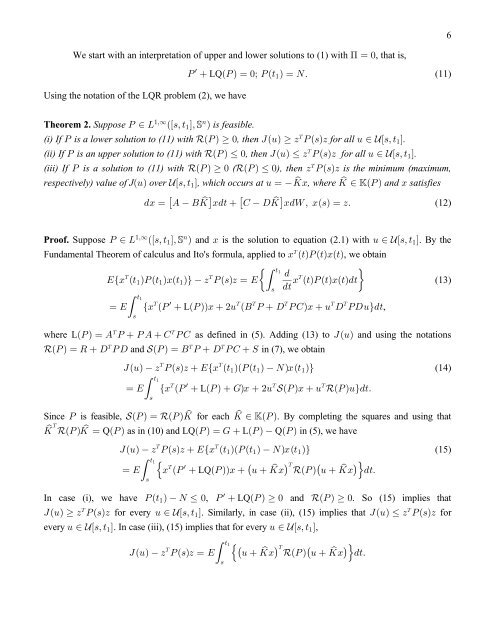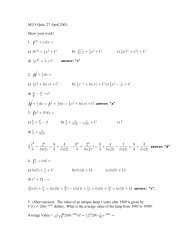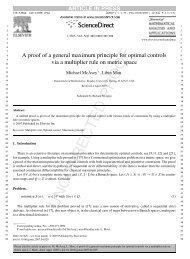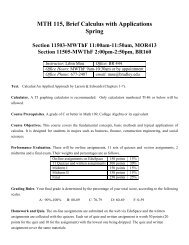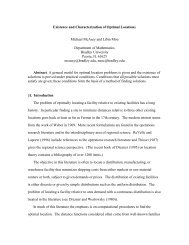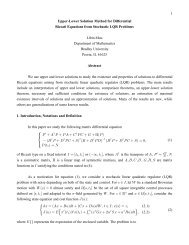1 Upper-Lower Solution Method for Differential Riccati Equations ...
1 Upper-Lower Solution Method for Differential Riccati Equations ...
1 Upper-Lower Solution Method for Differential Riccati Equations ...
Create successful ePaper yourself
Turn your PDF publications into a flip-book with our unique Google optimized e-Paper software.
6<br />
We start with an interpretation of upper and lower solutions to (1) with<br />
Using the notation of the LQR problem (2), we have<br />
w<br />
C œ! , that is,<br />
T € L Q aTb œ!à Ta> b œ R.<br />
(11)<br />
"<br />
Theorem 2. Suppose T P<br />
"ß_ "<br />
8<br />
ac=ß> d ß’ b is feasible.<br />
(i) If T is a lower solution to (11) with eaTb !, then N a? b D X T ab =D<strong>for</strong> all ? h c=ß><br />
" d.<br />
(ii) If T is an upper solution to (11) with eaT b Ÿ !, then N a? b Ÿ D X T ab =D <strong>for</strong> all ? h c=ß><br />
" d.<br />
X<br />
(iii) If T is a solution to (11) with eaTb !(<br />
eaT b Ÿ !), then D T ab =Dis the minimum (maximum,<br />
respectively) value of J a? b over hc=> ß " d, which occurs at ?œ OB s , where O s ŠaTb<br />
and B satisfies<br />
.B œ E FOs‘ B.>€ G HOs‘ B.[ßB= ab œDÞ<br />
(12)<br />
"ß_ 8<br />
Proof. Suppose TP ac=ß> d ß ’ b and B is the solution to equation (2.1) with ? hc=><br />
ß d.<br />
By the<br />
" "<br />
Fundamental Theorem of calculus and Ito's <strong>for</strong>mula, applied to B X<br />
ab >T ab >B> ab, we obtain<br />
"<br />
X X<br />
.<br />
X<br />
IeB a> " bT a> " bB> a " bf D T ab =DœIœ(<br />
B ab >T ab >B>.> ab<br />
.><br />
><br />
X X X X X X<br />
œI( eB aT € L aTbbB€#? aF T€HTGB€?HTH? b<br />
f.><br />
,<br />
=<br />
"<br />
w<br />
=<br />
><br />
(13)<br />
X<br />
X<br />
where L aTb œE T€TE€G TG as defined in (5). Adding (13) to N a?<br />
b and using the notations<br />
X X X<br />
eaTb œV€HTH and faTb<br />
œ F T€HTG€Win (7), we obtain<br />
X<br />
X<br />
N a? b D T ab =D€IeB a> baT a> b RB> b a bf<br />
><br />
" " "<br />
X X X<br />
œI( eB aT € LaT b€KB€#? b faTbB€? eaT b? f.>Þ<br />
=<br />
"<br />
w<br />
Since T is feasible, faTb œ eaTbOs<br />
<strong>for</strong> each O s ŠaTb. By completing the squares and using that<br />
Os<br />
X ea TOœ b s Q a T b as in (10) and LQaTb<br />
œK€ L aTb<br />
Q a T b in (5), we have<br />
(14)<br />
X<br />
X<br />
N a? b D T ab =D€IeB a> baT a> b RB> b a bf<br />
><br />
" " "<br />
X w<br />
X<br />
œI( š B aT € LQaT bbB€ ˆ ?€OB s ‰ e aT bˆ ?€OB s ‰›.>.<br />
=<br />
"<br />
(15)<br />
w<br />
In case (i), we have T a> b RŸ! , T € LQ aT b ! and e aT b !. So (15) implies that<br />
"<br />
X<br />
X<br />
N a?<br />
b D T ab =D <strong>for</strong> every ? h c=ß> " d. Similarly, in case (ii), (15) implies that N a? b Ÿ D T ab =D<strong>for</strong><br />
every ? hc=ß> d. In case (iii), (15) implies that <strong>for</strong> every ? hc=ß><br />
d,<br />
" "<br />
><br />
X<br />
X<br />
N a? b D T ab =DœI ( š ˆ ?€OB s ‰ eaT<br />
bˆ ?€OB s ‰›.>Þ<br />
=<br />
"


